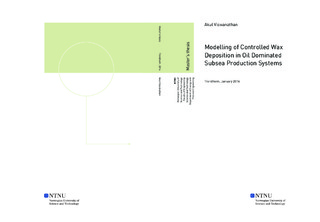| dc.description.abstract | The Arctic region is one of the remaining unexplored areas where large discoveries of petroleum still can be made. Large portions of the world's remaining worldwide undiscovered conventional hydrocarbon resources are foreseen to be located in this region. Deep water or ultra-deep water developments are also relevant in today's market. For this reason, the oil and gas industry is currently moving production into deeper waters, more remote areas and to colder environments without much infrastructure in place. In order to provide solutions to the market, Subsea 7 is currently developing proposals for solutions to transport crude oil at ambient seawater temperature, also known as cold flow technology. This can be introduced to improve the economy of field developments.
Wax deposition in subsea pipelines is a major flow assurance challenge, especially in the previously mentioned areas and scenarios. This thesis reviews the problem related to wax precipitation and deposition in subsea oil pipelines, and how this problem can be solved. Proposals are made for a unit chosen to be called the controlled wax deposition unit, which is a subsea concentric heat exchanger where wax is precipitated. The product fluid flows in the inner pipe, whereas the seawater is pumped through the annulus. This unit yields a cold flow solution for the crude oil, i.e. the product fluid is transported from the wellhead to the unit and then transported at ambient seawater temperature to topside. Most of the wax will precipitate and some deposit in the unit due to the temperature change. The deposited wax can be removed with a pig that goes in a loop in the unit, a pigging loop. Heat and mass transfer equations are discussed and used to create a program, which is written in MATLAB, calculating various values, e.g. wax thickness and pressure drop. After tuning, the Matzain and the Heat Analogy models are the wax models that coincide best with the experimental data. The MATLAB program yields a maximum wax thickness of 1.3 mm in the deposition unit, after seven days of operation. According to the simulation result: A good pigging frequency will be about 7 days for a 6 km long pipeline, and about 2-3 days for a 4 km long pipeline. | en |

